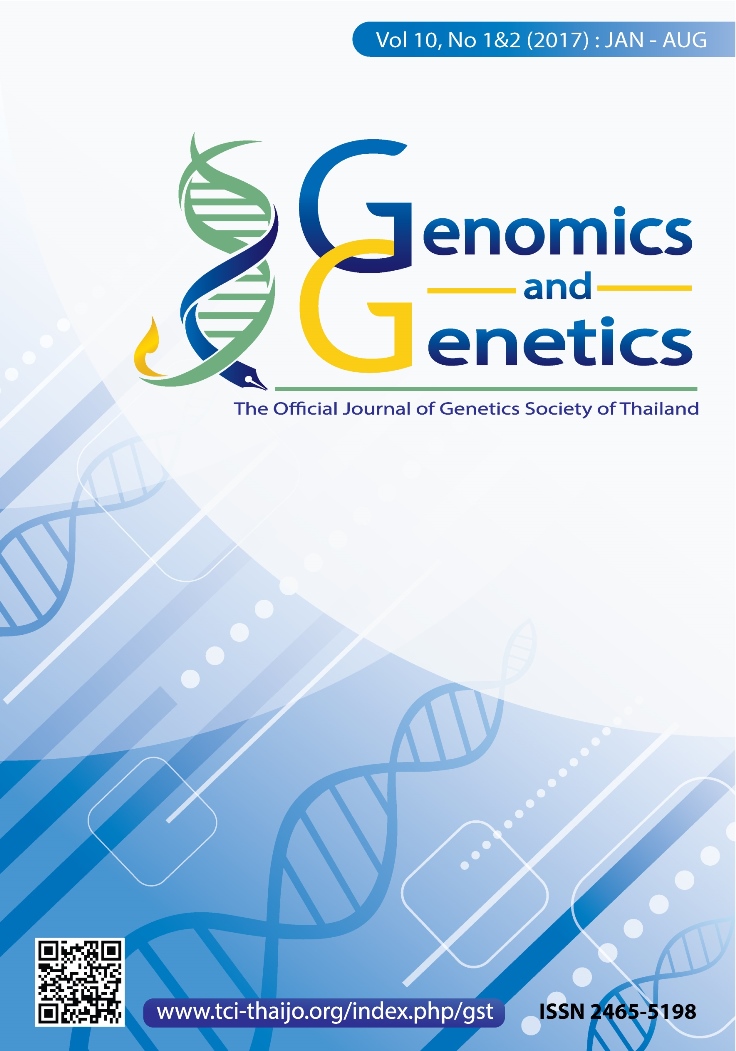Newly developed automated-massively parallel sequencing presenting the accuracy of hepatitis C virus genotyping and application on resistance-associated variants detection
DOI:
https://doi.org/10.14456/gag.2017.1Keywords:
, HCV genotyping, mixed-HCV infection, massively parallel sequencing, Sanger sequencingAbstract
Most hepatitis C virus (HCV) infection becomes chronic diseases and predictably develops into liver cirrhosis or hepatocellular carcinoma. HCV can be classified into 7 genotypes (GT) and multiple subtypes (ST). HCV treatment guidelines focus on determining the accuracy of HCV genotyping and subtyping, before starting treatment in all HCV-infected individuals. Efficient HCV genotyping and subtyping have become essential tools for indicating the optimal treatment. Current routine assays for HCV genotyping are easy and quick turnaround, but apparently subtyping is limited to identification. This study evaluated the accuracy of HCV genotyping in a newly developed automated-massively parallel sequencing (MPS) technique of previously identified HCV-infected specimens. The results indicated that by using the reference method, MPS and a bioinformatic pipeline, the genotype and subtype had identical accuracy of 95.65%. Interestingly, MPS could detect the remaining 4.35% as mixed-HCV type infected specimens, while the reference method could not. This result indicated that the MPS technique was highly accurate in identifying the HCV genotype and mixed-type infection. In addition, MPS can detect resistance-associated variants (RAVs) simultaneously with the HCV genotyping, especially in HCV GT1-infected specimens. Since HCV GT1 has a highly frequent presence of pre-existing RAVs, with resistance associated to direct-acting antivirals (DAAs), this study found that up to 60% of HCV GT1 sample were RAVs. This discovery of important RAVs in the patient infected with HCV GT1 could be beneficial in guiding the therapy decisions while avoiding the use of some DAAs. Thereby, the opportunity for patients to access the best treatment is enhanced.
References
AASLD-IDSA panel (2016a) Initial treatment of HCV infection. Hepatitis C guidance: Recommendations for Testing, Managing, and Treating Hepatitis C, http://www.hcvguidelines.org/full-report/initial-treatment-hcv-infection (November 2016)
AASLD-IDSA panel (2016b) Retreatment of a person with chronic HCV infection in whom prior therapy has failed. Hepatitis C guidance: Recommendations for Testing, Managing, and Treating Hepatitis C, http://www.hcvguidelines.org/full-report/retreatment-persons-whom-prior-therapy-has-failed (November 2016)
Ahmed A, Felmlee DJ (2015) Mechanisms of hepatitis C viral resistance to direct acting antivirals. Viruses 7: 6716–6729.
Au TH, Destache CJ, Vivekanandan R (2015) Hepatitis C therapy: Looking toward interferon-sparing regimens. J Am Pharm Assoc 55: e72–e86.
Avo AP, Agua Doce I, Andrade A, Padua E, (2013) Hepatitis C virus subtyping based on sequencing of the C/E1 and NS5B genomic regions in comparison to a commercially available line probe assay. J Med Virol 85: 815–22.
Chevaliez S, Pawlotsky JM (2006) HCV genome and life cycle. In: Tan SL (ed) Genomes and molecular biology. Hepatitis C Viruses, Horizon Bioscience, pp. 5–47.
Chung RT, Davis GL, Jensen DM, Masur H, Saag MS, Thomas DL (2015) Hepatitis C guidance: AASLD-IDSA recommendations for testing, managing, and treating adults infected with hepatitis C virus. Hepatology 62: 932–954.
Cunningham EB, Applegate TL, Lloyd AR, Dore GJ, Grebely J (2015) Mixed HCV infection and reinfection in people who inject drugs-impact on therapy. Nat Rev Gastroenterol Hepatol 12: 218–30.
EASL (2015) EASL Recommendations on Treatment of Hepatitis C 2015. J Hepatol 63: 199–236.
Enache EL, Enache LS (2008) Versant HCV genotype 2.0 assay (LiPA) in hepatitis C virus genotype determination. Rev Romana Med Lab 12: 47–53.
Geno2pheno hcv [Internet]. Germany: GENAFOR; 2011 [updated 2017 Feb 24; cited 2017 Mar 13]. Available from: http://hcv.geno2pheno.org/index.php.
Gryadunov D, Nicot F, Dubois M, Mikhailovich V, Zasedatelev A, Izopet J (2010) Hepatitis C virus genotyping using an oligonucleotide microarray based on the NS5B sequence. J Clin Microbiol 48: 3910–3917.
Lenz O, Verbinnen T, Fevery B, Tambuyzer L, Vijgen L, Peeters M, Buelens A, Ceulemans H, Beumont M, Picchio G, et al. (2015) Virology analyses of HCV isolates from genotype 1-infected patients treated with simeprevir plus peginterferon/ribavirin in Phase IIb/III studies. J Hepatol 62: 1008–1014.
Li Y, Yamane D, Masaki T, Lemon SM (2015) The yin and yang of hepatitis c: Synthesis and decay of hepatitis c virus RNA. Nat Rev Microbiol 13: 544–558.
Liu CH, Liang CC, Liu CJ, Lin CL, Su TH, Yang HC, Chen PJ, Chen DS, Kao JH (2015) Comparison of Abbott realtime HCV genotype II with Versant line
probe assay 2.0 for hepatitis C virus genotyping. J Clin Microbiol 53: 1754–1757.
McHugh ML (2012) Interrater reliability: the kappa statistic. Biochem Med 22: 276–282, https://www.ncbi.nlm.nih.gov/pmc/articles/PMC3900052/?report=printable (November 2016)
Poveda E, Wyles DL, Mena Á, Pedreira JD, Castro-Iglesias Á, Cachay E (2014) Update on hepatitis C virus resistance to direct-acting antiviral agents. Antiviral Res 108:181–191.
Quer J, Gregori J, Rodriguez F, Buti M, Madejon A, Perez del Pulgar S, Garcia Cehic D, Casillas R, Blasi M, Homs M, et al. (2015) High-resolution hepatitis C virus subtyping using NS5B deep sequencing and phylogeny, an alternative to current methods. J Clin Microbiol 53: 219–26.
Sarrazin C, Lathouwers E, Peeters M, Daems B, Buelens A, Witek J, Wyckmans Y, Fevery B, Verbinnen T, Ghys A, et al. (2015) Prevalence of the hepatitis C virus NS3 polymorphism Q80K in genotype 1 patients in the European region. Antiviral Res 116: 10–16.
Smith DB, Bukh J, Kuiken C, Muerhoff AS, Rice CM, Stapleton JT, Simmonds P (2014) Expanded classification of hepatitis C virus into 7 genotypes and 67 subtypes: updated criteria and genotype assignment web resource. Hepatology 59: 318–27.
Tan CL, Hassali MA, Saleem F, Shafie AA, Aljadhey H, Gan VB (2015) Development, test-retest reliability and validity of the Pharmacy Value-Added Services Questionnaire (PVASQ). Pharm Pract 13: 598
Thai Association for the Study of the Liver (2016) Thailand Practice Guideline for Management of Chronic Hepatitis C 2016. Thai Association for the Study of Liver, pp. 7–32.
World Health Organization (2014) Guidelines for the screening, sare and treatment of persons with hepatitis C infection.
Wyles DL (2013) Antiviral resistance and the future landscape of hepatitis C virus infection therapy. J Infect Dis 207: S33–S39.
Wyles DL, Gutierrez JA (2014) Importance of HCV genotype 1 subtypes for drug resistance and response to therapy. J Viral Hepat 21: 229–40.



